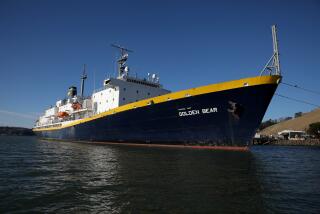IN THE NEIGHBORHOOD : San Pedro: Ocean Lessons in Teamwork and Responsibility
In San Pedro, a working-class town that is home to the nation’s busiest commercial port, the Los Angeles Maritime Institute introduces youths from disadvantaged backgrounds to sailing. Educational programs aboard ships have long provided young people with character-building experiences, but most such programs are costly. The institute was founded in 1992 by San Pedro resident Jim Gladson, a retired science teacher who coordinated school-sposored sailing trips for students and staff in the Los Angeles Unified School District for nearly 20 years.
Participants sail with an instructional crew on the Swift of Ipswich, a donated 70-foot schooner once owned by actor James Cagney. Youths learn about teamwork and responsibility by understanding the vessel and mastering tasks such as raising sails, helping to plot and monitoring radio transmissions. The modest operation, which has served about 50 young people so far, relies on funding from youth groups and charitable public agencies. Office space is donated by the Los Angeles Maritime Museum, with which the institute is affiliated.
Population:
San Pedro: 69,482
Los Angeles: 3,485,398
Population by Race and Ethnicity
San Pedro:
White: 55%
Hispanic: 34%
Black: 5%
Asian: 5%
Other: 1%
Los Angeles
White: 37%
Hispanic: 40%
Black: 13%
Asian: 9%
Other: 1%
Source: U.S. Census programming by Times analyst Sandy Poindexter
Population:
San Pedro: 69,482
Los Angeles: 3,485,398
Population by Race and Ethnicity
San Pedro:
White: 55%
Hispanic: 34%
Black: 5%
Asian: 5%
Other: 1%
Los Angeles
White: 37%
Hispanic: 40%
Black: 13%
Asian: 9%
Other: 1%
Source: U.S. Census programming by Times analyst Sandy Poindexter
COMMUNITY WORKER
CULBERTO CARDENAS
San Pedro resident for 13 years and Assistant Program Coordinator for Lomita’s Harbor Hills Housing Project
In low-income housing the only people who have money are people are doing something illegal. Sometimes such people end up being glorified. If you show these kids other things to do than the way they’ve been living life, they can learn that there’s more than what’s in the neighborhood. Some of the kids here participated in the program, and some of them had been were flirting with the gangs. We went out about eight times on the ship.
When you take them onto a ship where there’s not a lot of room and there’s a lot of work to do you get them a little disoriented and suddenly they have to learn how to depend on each other. They don’t just learn about sailing--they take ownership of the experience. They even voted out somebody who was causing a lot of problems. Since the trips the kids have come to me and suggested other services for the residents here. They see themselves as a kind of youth council representing Harbor Hills.
STUDENT
PAIGE GIBBONS
13 years old, 8th grader at Dotson Middle School in San Pedro
I live in Harbor Hills. My favorite part on the Swift was working hard, pulling the ropes; the part I didn’t like was that there weren’t any showers. Instead of being here with nothing to do, the sailing taught us to look at the sea as more than just water--it’s a place to go to, it’s a place to take care of. I learned that you can put your mind to anything and it doesn’t matter if you’re a male or female, you can do anything if you try. I tried for myself and I did it--I steered that boat. I used to have a bad attitude and I think the sailing brought me closer to people because it taught me about teamwork.
AN OUTSIDE ASSESSMENT
MAGIE VALDES
Director of Communication for Associated Marine Institute, a private, non-profit organization in Tampa, Fla., that offers sail training for court and school-referred youth
Programs for kids “at risk” are a great idea, because you catch them before they’ve broken the law--you’re doing preventive work. I don’t think it’s the sailing or the marine setting that makes it effective--it’s taking kids out of their environment, giving them something challenging to do and showing them that they can do something different. And this way the kids get to feel they belong. Sailing is one way to teach that because if you’re in charge of the jib or the mainmast, you’ve got to be there--you can’t be down below drinking a Coke because you’ll run aground. You learn that everyone’s depending on you and that you can be depended on.
TO GET INVOLVED
For information about programs or volunteer, donation and other support opportunities with the Los Angeles Maritime Institute call (310) 548-7618. The institute also raises money by leasing the ship to paying groups.
More to Read
Sign up for Essential California
The most important California stories and recommendations in your inbox every morning.
You may occasionally receive promotional content from the Los Angeles Times.










